High O[C]tane
So, last week concluded the 1st wave of major exams. What better way to enjoy your victory lap than to enjoy pizza and great anime with friends? As it turns out, there’s a lot of better ways, but you ended up doing this instead. Today, I’m discussing the thrilling conclusion to [C] and the anime movie REDLINE. Put the pedal to the (death) metal and start reading!
[C] 9 – 11
Episode 9 is all about dealing with the collapse of the Southeastern Asian Financial District. The IMF has an emergency meeting to discuss the potential consequences of the event known as [C]. However, it’s too little, too late, as the Assets Counter in Singapore reaches 0. Immediately, buildings and people begin disappearing in large swaths all throughout the country. Within minutes, the entire country of Singapore is erased from existence. In Japan, Ms. Sato watches the Asian stock exchanges as [C] literally sends shockwaves throughout the region.
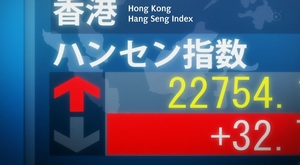
When stocks go from this…
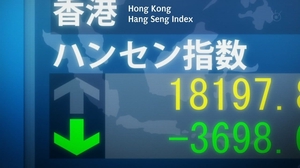
…to this IN TWO SECONDS, I reach for my gun.
Without a massive influx of money, Japan will be finished, but Mikuni has other plans. As the (by far) wealthiest Entré in the Far Eastern District, Mikuni possesses a Darkness card.
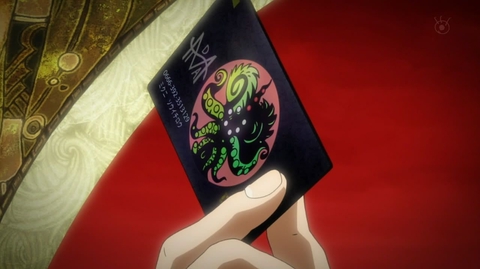
Kid tested, Chthulu approved.
With it, Mikuni can directly control the amount of Midas Money in circulation within the District. However, the price of directly printing more Midas Money is 20 years off one’s lifespan. Considering that he and the rest of Japan will be erased if he doesn’t, Mikuni agrees. With that, the giant coin in the center of the District flops onto its side, and a giant hole opens up within the coin. Next, a gigantic rotary press descends from the ominous red sky and rainbow-colored light washes in from all directions towards the press. The shocking revelation is that Midas Money is literally made by using people’s Futures.
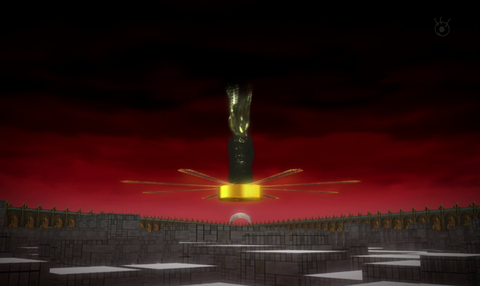
What could possibly go wrong?
Resigned to his decision, Mikuni rushes back to the real world to meet with the Starling Guild executive members. As the [C]-wave reaches Japan, the Guild frantically buys up everything in sight, sparing 80% of the country’s major corporations and banks. Unfortunately, Mikuni forgot about one little bitty detail: since all that Midas Money he just printed is made by directly using people’s Future, the collateral taken is the Future of all of Japan.
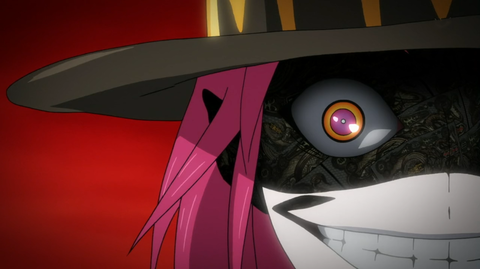
Now we know what REALLY lies underneath all that playful candor.
Later, Ms. Sato meets with Kimimaro to discuss the aftermath of [C]. Mikuni may have stopped the collapse of Japan, but he had to halve the country’s GDP to do so. Essentially, Japan has regressed back to its economic state twenty years ago, commonly referred to in economics as “The Japanese Lost Decade.” However, she has more than just doom and gloom for Kimimaro, telling him that the Info Broker has some interesting information regarding his Asset.
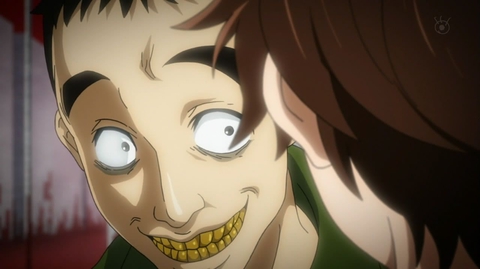
About as legit as your neighborhood Meth dealer.
As it so happens, Kimimaro’s father had an Asset that looked exactly like MSYU, named MUA. The Broker suggests that Kimimaro may have shared a similar Future to that of his father. Before leaving, the Info Broker also gives Kimimaro an additional photo, free of charge. Ms. Sato believes that this proves that Kimimaro’s father loved him, suggesting that they both struggled for the same Future. As such, Kimimaro should find something to fight for and protect, and he had better do so soon.
In the real world, things are rapidly falling apart. Hanabi has a constantly gaunt and miserable expression. Everyone around Kimimaro just says that the days go on and on. In fact, they become rather annoyed whenever he asks if anything else has happened, since obviously nothing happens anymore.
…And then the Settlement hit.
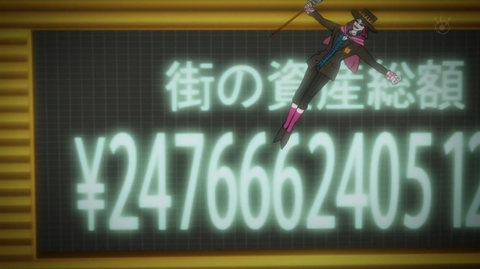
I'm RICH! I'm wealthy, I'm financially independent, socially secure!
Since the Settlement affects the Future of Japan, practically everything child-oriented, including schools, theme parks, and playgrounds have become ghost towns or shanty towns. The government releases a report that only 3 children were born in the entire country within the last week. The old man who worked with Kimimaro disappears right before his eyes. As for Hanabi, she acts as though she’s never even met Kimimaro, becoming almost completely autistic. Meanwhile, Mikuni sits at an empty playground, surveying the pitiful Present that he has protected.
After witnessing the effects of “saving Japan” with Midas Money, Kimimaro agrees to help Ms. Sato to destroy the Financial District. He speaks with MSYU, saying that with the District gone, she will likely become his daughter in the future. However, MYSU, who has only the Present to share with Kimimaro, resents his decision. She demands that he kiss her, so he grants her request. He kisses her on the forehead, telling her that it’s a kiss for an important person.
Episode 10 begins the fight for Japan. In order to protect the U.S. from [C], Sato’s superior at the IMF orders his District’s Masakaki to take steps to drive down the value of currencies around the world.
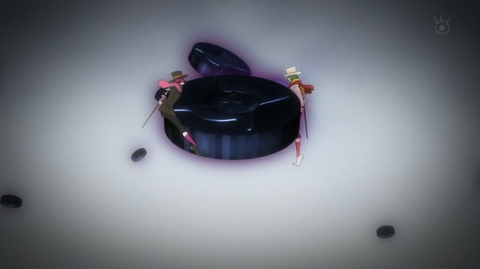
Masakaki is so bored, he tries to troll himself.
This prompts Mikuni to fire up the Rotary Press once again. Fearing what will happen as a result of the next Settlement, Kimimaro and Ms. Sato work with the Info Broker to break the trust in Midas Money itself. However, they must essentially destroy the Yen in order to do so. Since the Japanese Midas Money is tied to the Yen, they need to make the Yen worthless, take Mikuni’s Darkness card, and reverse the Rotary Press, thus returning the Future to Japan. The problem is, they need to do all of this in a mere 2 hours. Fortunately, the Info Broker has tons of clout with….everyone, including the press, the internet, and the man in charge of the Defensive Funds at the Starling Guild. After draining a substantial amount of money out of the Defensive Fund (about ¥2 Trillion), he distributed it to every personal bank account in Japan. He also hired a helicopter to dump money from the sky, for good measure. All the while, he also leaks the info to the press and spams social media and text messaging services that the Yen is experiencing hyper-flation, telling everyone to dump the Yen and buy the Dollar.
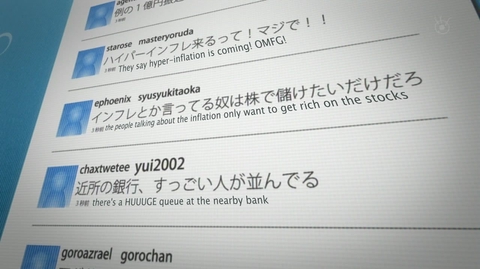
ZOMGLAR Hyperflation!!! Fuck the Yen, buy the Dollar!
In the District, Sato and Kimimaro will make a Deal with Mikuni and the Guild members, respectively. Kimimaro enters a Deal with Mikuni’s strongest follower (who I will refer to as Love). However, the rapid influx of Midas Money weakens MSYU and the other Assets (since an Asset’s strength is directly proportional to the strength of the currency). Fortunately, Kimimaro uses a Macro-flation to defeat Love, allowing him to confront Mikuni. Sato puts up a good fight against Mikuni, but he is still by far the wealthiest man in the District, so he dispatches Sato with ease. In order to maximize Kimimaro’s chance of success, she gives him her Asset just before going Bankrupt. Mikuni states that Kimimaro is powerless to stop him, but Masakaki decides to turn Kimimaro’s card into a Darkness card, saying that now Kimimaro has the power to reverse the Rotary Press. Mikuni demands to know why Masakaki is siding with Kimimaro, to which he states that he is merely acting as directed by the Investors. Of course, Mikuni refuses to back down, and the stage is set for the final Deal of the Financial District.
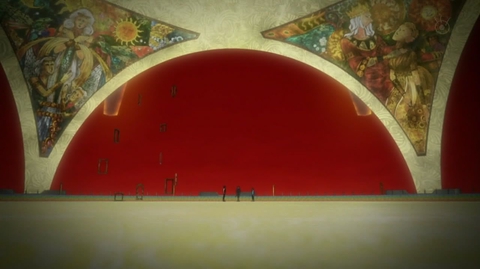
OPEN DEAL!!!
The final episode of [C] details the battle between Kimimaro and Mikuni and the collapse of the Yen. Unlike the fight we were cheated of between Kimimaro and Kou, this Deal is pretty epic. Meanwhile, the hyper-flation perpetrated by the Info Broker spreads throughout Japan, leading to bank runs and the halt of all international trade involving the Yen. Civil unrest tears through the country, and the [C]-wave caused by the U.S. is heading straight for Japan. Now the race is on to see which will disappear first, the Financial Distract or Japan.
As the Deal rages on, MYSU tries to convince Q that if she continues fighting, it won’t be for Mikuni. Q then takes her true form: Mikuni’s sister Takako (or rather the form of Takako). Mikuni then reveals that he knew that Japan and mankind would be destroyed at the hands of the Financial District, so he would use his remaining time to protect the present and his sister. Meanwhile, the Info Broker frantically photographs the fight while speeding towards the Gate of the Financial District. At last, faith in the Yen is destroyed, and the Midas Money reverts to being black paper, which then disappears from people’s very hands. Just as Kimimaro and Mikuni go to deliver the final blow, the Assets counter displays MARKET CLOSURE in giant red letters. With that, the Midas Money to vanishes, and Kimimaro knocks out Mikuni.
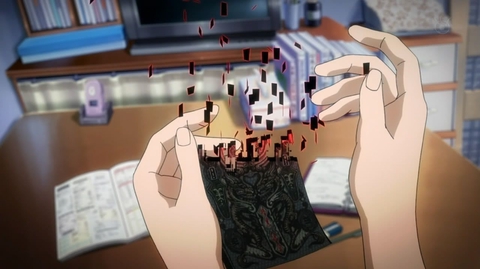
Talk about having money to burn.
Now the victor, Kimimaro orders Masakaki to reverse the Rotary Press. The Midas plates that cover the Press evaporate and the rainbow-licious spheres that represent the individual Futures begin to flood the District and the real world. The Info Broker muses about the nature of trust, but the Driver informs him his reality will become far different because his success was so tightly related to the District. No District means no success. Mikuni and Kimimaro bid fond farewell to their Assests, and Mikuni decides to remain in the District as it dissolves. Kimimaro, on the other hand, gets to meet Midas, the creator of the Financial District. He states that in the end, Kimimaro, Mikuni, Sato, and the Info Broker were all correct in their views, that all the misery generated from using the Financial District is in the name of bettering mankind.
Fortunately, the reality that Kimimaro returns to is far better than the one that he first experienced at the beginning of the story. Children are everywhere, and even Hanabi has realized her dream of becoming an elementary school teacher. However, Masakaki appears next to Kimimaro, saying that as long as there is a Future, there will also be a Financial District.
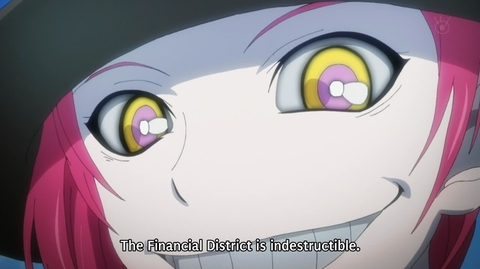
That’s right, Masakaki is literally untrollable.
On that cheerful note, Masakaki invites Kimimaro to come to the District any time he feels like making a Deal and promptly disappears. Finally, Kimimaro pulls out the photograph given to him by the Info Broker, noting that he should have smiled.
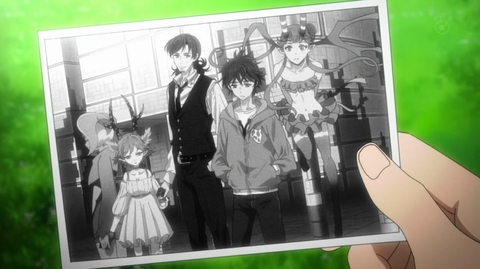
Just don’t show your daughter that photo. It might warp her little mind.
So it’s pretty obvious that the producer decided to save the budget until the ending was animated, since the animation quality is by far the best in these last episodes. The conclusion of the final Deal feels kinda cheap, but then how else do you expect Kimimaro to beat someone who’s so incredibly more powerful. The encounter with Midas also seems a bit lackluster, since he basically explains that everyone was right. This mentality assumes that everyone is working to better the world in some fashion, but many people are obviously selfish, acting only for themselves. Midas might have been making the point that, in the grand scheme, it all nets positive, but it just doesn’t seem right. However, the ending itself is…ok. The problem is that I didn’t want an ok ending, but a great one. Although the ending is basically what you expect, it could have been done better.
Now for the series overall, I will use the litmus test that Chris has so graciously provided. For those that don’t remember it, here’s the gist. Anime typically have 3 goals. One: create a unique, rich universe to build in. Two: create a complex, dynamic cast of characters that live in this universe. Three: create a believable, compelling story that drives the anime forward.
That said, [C] does create a very unique and rich world that is meant to reflect the real world and vice vice versa. It also creates a believable story, and though it felt a bit slow in the middle episodes (all 2 of them), I did feel compelled to find out more about the overall story, since it’s obviously not just about the main protagonist. It’s in the character department that [C] gets a little iffy. The main characters themselves are actually pretty enjoyable, and even Kimimaro can be interesting at times. I mean, he does have his own thoughts, reflections and emotions. He can also relate to viewers, since he’s basically a young man who thought it was enough to just work hard and live a modest life, but is then thrown into a position in which he must call into question his place in the world. The problem is that while the main characters (all 6 of them) have at least 2 dimensions to them, the side characters feel forced. If a character can be easily replaced, then I feel that they shouldn’t be included in a story, especially a 1-cour series. This is easily fixed by having the characters interact more closely with one another, but [C]’s side characters are always held at a distance. Case in point, Hanabi, the supposed love interest who was even in the very first and last scenes that we see Kimimaro in. However, the best she becomes is a barometer for the state of the real world. Meanwhile the main character interaction gets awfully repetitive. Kimimaro talks with Mikuni, then MYSU, then Mikuni, then the Info Broker, then Mikuni, then Kou, then Mikuni. It sounds boring just typing it. Not that the characters don’t have interesting things to say, but they develop this pattern that never really sat well with me. I do at least like that some topics actually illicit meaningful reaction from Kimimaro, who often seems pretty aloof. Other mentionable quirks are the small patches of crummy character animation (Masakaki seems to get it most often) and the lack of budget at times (most notably during Kimimaro and Kou’s Deal), and the sheer number of troll faces that pack an 11 episode series.
While [C] may lack the razzle dazzle dark mood of shows like Madoka Magica, it’s also a very original series that simply tries to tell an interesting story for a few hours. For the most part, it accomplishes that task and with decent results.
I give [C] 8.0 out of 10.
REDLINE
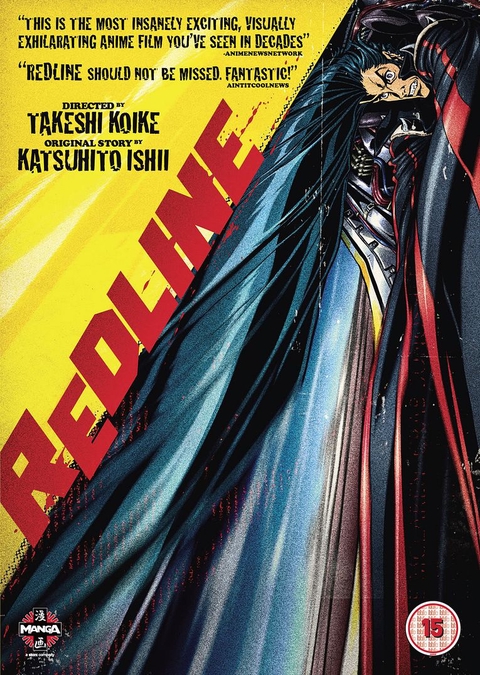
Big cars, bigger hair.
Released in 2009, REDLINE is the culmination of a 5-year project by Studio MADHOUSE (It’s a Madhouse! A MAAAADHOOUUSE!!!). It is directed by the Takeshi Koike, the key animator for Dead Leaves, Samurai Champloo and The Animatrix. If you’ve never seen his work before, you’re certainly in for an experience.
The story centers around young man named JP, who is an illegal racer. After narrowly losing the qualifying race Yellow Line to the eventual love interest Sonoshee McLaren, he is selected as an Alternate for REDLINE, the greatest race in the galaxy that takes place every 5 years. Since the race location is determined about a week before the event, any racers who find the conditions unfavorable must drop out right away. As it so happens, this year’s REDLINE will take place on Roboworld, which is home to a militaristic cyborg civilization that has vowed to annihilate any racers attempting to set foot on the planet. However, some of the other racers have special talents, like using magic to mark and connect to the finish line, and infiltrating and disabling a giant satellite cannon.
JP is the driver in a team of his close friends, including an old junk dealer and a mechanic-turned mobster named Frisbee. In order to secure the money for world-class parts, Frisbee has had to sabotage the JP’s engine to fail in the final stretch of his races. It also turns out that JP watched Sonoshee in a race when she was very young, and he has multiple times to court her before the race. The plot drags a little at this point, but not for long.
From this point on, REDLINE becomes Wacky Races: the Anime, as the racers do whatever they can to win before the forces of Roboworld kill them. Somewhere in the Mine Field, Sonoshee’s car gets totaled, and JP offers to help her win…in his car. As the syndicate is about to blow up JP’s car and kill Frisbee, the Junk Dealer saves the day by basically shooting everyone else in the room. After about another 20 minutes of insanity, the home stretch is in sight, where JP and Sonoshee pull out all the stops to beat the reigning champion Machine Head. In a drunken stupor, the Junk Dealer accidentally triggers the 3-stage bomb under JP’s car, giving the two just enough speed to literally jump ahead of Machine Head by the length of JP’s hair and win the race. An anti-gravity field generated to slow down the winners, lest they get launched into orbit, and JP and Sonoshee make out in it. The End.
Now, while this movie has enough storyline to fit between The Borrower Arrietty and the Precure Movie, that really isn’t what gives this film its appeal. It’s the world presented in it and the animation itself. It is straight-up insane. The detail is phenomenal, the characters are ridiculous, the race scenes are preposterous, the fan service is off the charts, and yet one can sit in that chair and find this all entirely believable. THAT is a presentation that sucks you in, and it does this for two solid hours.
You’re probably wondering why I haven’t included any screenshots in this section. Glad you asked. Actually, it’s because rescaling the images to fit on this page would be a gross disservice to the artwork. It really is that detailed. If I had to best describe REDLINE, it would be like taking an art gallery and turning it into a flip book. Seriously, it is damn hard to find a still frame in this movie that you couldn’t use as a desktop wallpaper. It is a celebration of all that is animation, and I couldn’t be happier with MADHOUSE’s latest triumph.
And with that, the CSM Anime Club returns to its regular 3 X 3 programming schedule. Study hard, as the 2nd wave of exams is a month away, and there’s no turning back. To those who haven’t yet dropped a class, congratulations. To the rest of you…well there’s always CU.